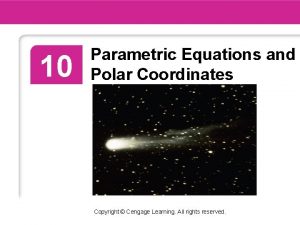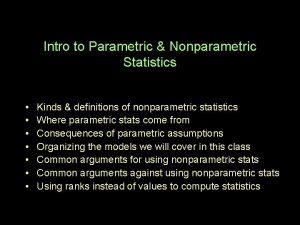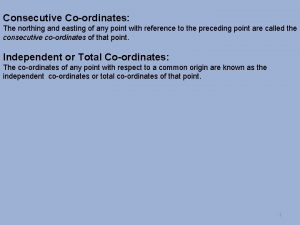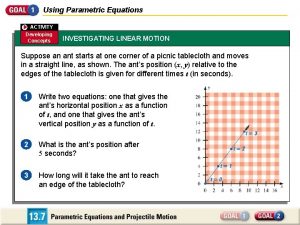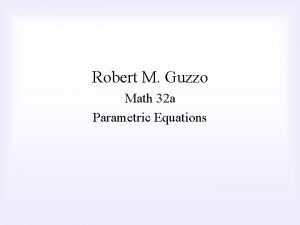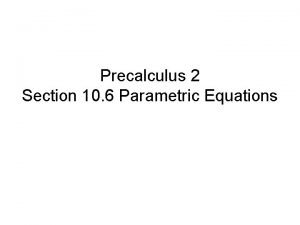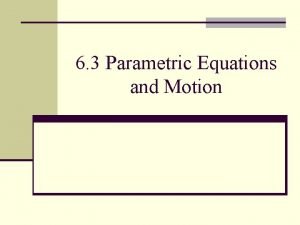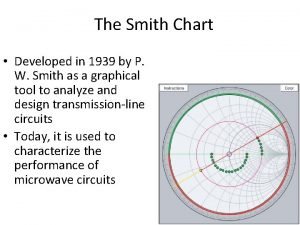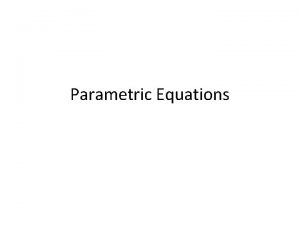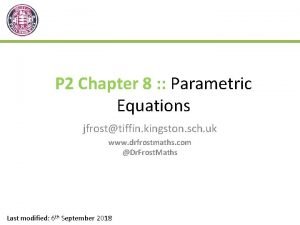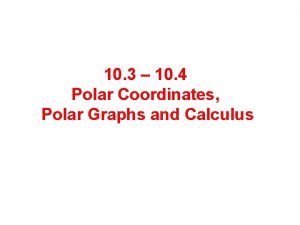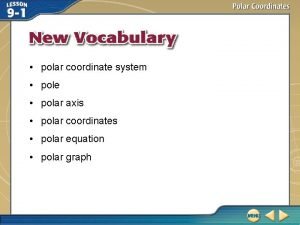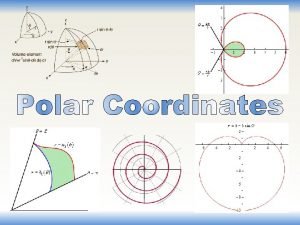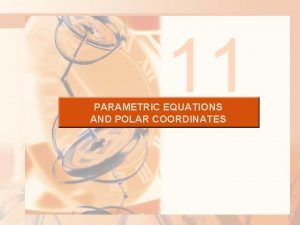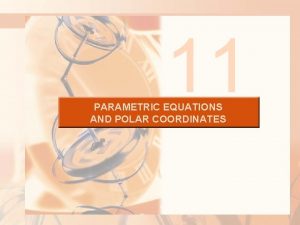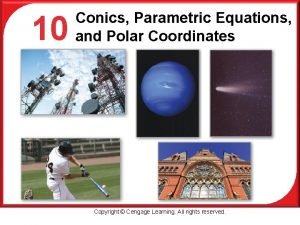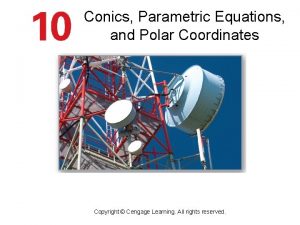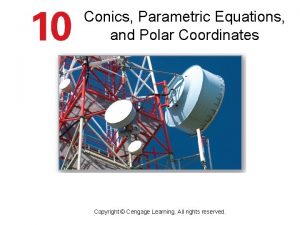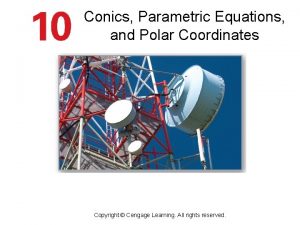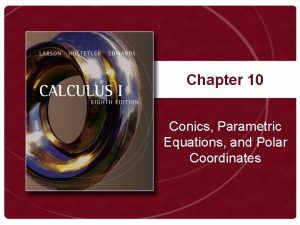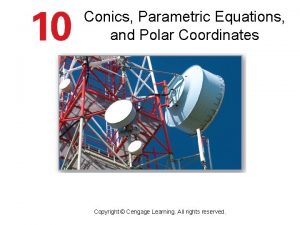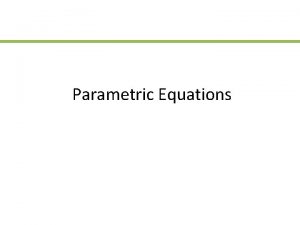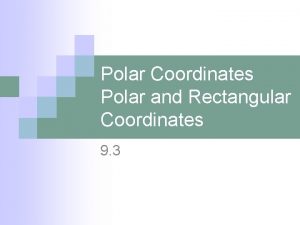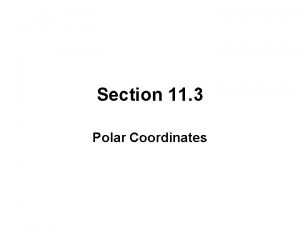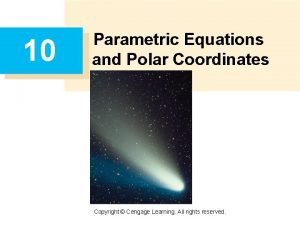10 P Conics Parametric Equations and Polar Coordinates

























- Slides: 25

10 P Conics, Parametric Equations, and Polar Coordinates Copyright © Cengage Learning. All rights reserved.

10. 6 Polar Equations of Conics and Kepler’s Laws Copyright © Cengage Learning. All rights reserved.

Objectives n Analyze and write polar equations of conics. n Understand use Kepler’s Laws of planetary motion. 3

Polar Equations of Conics 4

Polar Equations of Conics The next theorem uses the concept of eccentricity to classify the three basic types of conics. 5

Polar Equations of Conics Figure 10. 57 In Figure 10. 57, note that for each type of conic, the pole corresponds to the fixed point (focus) given in the definition. 6

Polar Equations of Conics 7

Polar Equations of Conics The four types of equations indicated in Theorem 10. 17 can be classified as follows, where d > 0. a. Horizontal directrix above the pole: b. Horizontal directrix below the pole: c. Vertical directrix to the right of the pole: d. Vertical directrix to the left of the pole: 8

Polar Equations of Conics Figure 10. 59 illustrates these four possibilities for a parabola. Figure 10. 59 9

Example 1 – Determining a Conic from Its Equation Sketch the graph of the conic Solution: To determine the type of conic, rewrite the equation as So, the graph is an ellipse with . 10

Example 1 – Solution cont’d You can sketch the upper half of the ellipse by plotting points from = 0 to = , as shown in Figure 10. 60. Then, using symmetry with respect to the polar axis, you can sketch the lower half. Figure 10. 60 11

Polar Equations of Conics For the ellipse in Figure 10. 60, the major axis is horizontal and the vertices lie at (15, 0) and (3, ). So, the length of the major axis is 2 a = 18. To find the length of the minor axis, you can use the equations e = c/a and b 2 = a 2 – c 2 to conclude that 12

Polar Equations of Conics Because , you have which implies that minor axis is yields . So, the length of the. A similar analysis for hyperbolas 13

Kepler’s Laws 14

Kepler’s Laws, named after the German astronomer Johannes Kepler, can be used to describe the orbits of the planets about the sun. 1. Each planet moves in an elliptical orbit with the sun as a focus. 2. A ray from the sun to the planet sweeps out equal areas of the ellipse in equal times. 3. The square of the period is proportional to the cube of the mean distance between the planet and the sun. 15

Kepler’s Laws Although Kepler derived these laws empirically, they were later validated by Newton. In fact, Newton was able to show that each law can be deduced from a set of universal laws of motion and gravitation that govern the movement of all heavenly bodies, including comets and satellites. 16

Example 3 – Halley’s Comet Halley’s comet has an elliptical orbit with the sun at one focus and has an eccentricity of e ≈ 0. 967. The length of the major axis of the orbit is approximately 35. 88 astronomical units (AU). (An astronomical unit is defined as the mean distance between Earth and the sun, which is 93 million miles. ) Find a polar equation for the orbit. How close does Halley’s comet come to the sun? 17

Example 3 – Solution Using a vertical axis, you can choose an equation of the form Because the vertices of the ellipse occur when = /2 and = 3 /2, you can determine the length of the major axis to be the sum of the r-values of the vertices, as shown in Figure 10. 62 18

Example 3 – Solution cont’d That is, So, and . Using this value in the equation produces where r is measured in astronomical units. To find the closest point to the sun (the focus), you can write. 19

Example 3 – Solution cont’d Because c is the distance between the focus and the center, the closest point is 20

Kepler’s Laws Kepler’s Second Law states that as a planet moves about the sun, a ray from the sun to the planet sweeps out equal areas in equal times. This law can also be applied to comets or asteroids with elliptical orbits. For example, Figure 10. 63 shows the orbit of the asteroid Apollo about the sun. Figure 10. 63 21

Kepler’s Laws Applying Kepler’s Second Law to this asteroid, you know that the closer it is to the sun, the greater its velocity, because a short ray must be moving quickly to sweep out as much area as a long ray. 22

Example 4 – The Asteroid Apollo The asteroid Apollo has a period of about 661 Earth days, and its orbit is approximated by the ellipse where r is measured in astronomical units. How long does it take Apollo to move from the position = – /2 to = /2, as shown in Figure 10. 64? Figure 10. 64 23

Example 4 – Solution Begin by finding the area swept out as increases from – /2 to /2. Using the substitution u = tan( /2), you obtain 24

Example 4 – Solution cont’d Because the major axis of the ellipse has length 2 a = 81/28 and the eccentricity is e = 5/9, you can determine that. So, the area of the ellipse is Because the time required to complete the orbit is 661 days, you can apply Kepler’s Second Law to conclude that the time t required to move from the position = – /2 to = /2 is which implies that 25
 Polar curve
Polar curve Site:slidetodoc.com
Site:slidetodoc.com Univariate analysis tests
Univariate analysis tests Nonparametric tests
Nonparametric tests Boris epshtein
Boris epshtein Polar equation
Polar equation Parametric
Parametric Consecutive coordinates in surveying
Consecutive coordinates in surveying Chapter 7 conic sections and parametric equations
Chapter 7 conic sections and parametric equations Perspective geometry
Perspective geometry 9-3 polar and rectangular forms of equations
9-3 polar and rectangular forms of equations Conic section cheat sheet
Conic section cheat sheet How to solve parametric equations
How to solve parametric equations Parametric equations word problems
Parametric equations word problems Parametric to rectangular
Parametric to rectangular Parametric motion
Parametric motion How to solve parametric equations
How to solve parametric equations Complete smith chart
Complete smith chart Parametric equations
Parametric equations Dr frost parametric equations
Dr frost parametric equations Rectangular and polar coordinates
Rectangular and polar coordinates Pole in polar coordinates
Pole in polar coordinates Pole in polar coordinates
Pole in polar coordinates Calculator art project
Calculator art project Initial line of cardioid
Initial line of cardioid Geodesic polar coordinates
Geodesic polar coordinates
